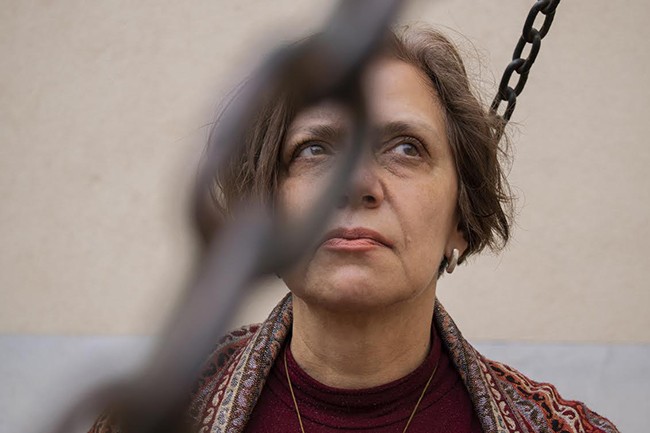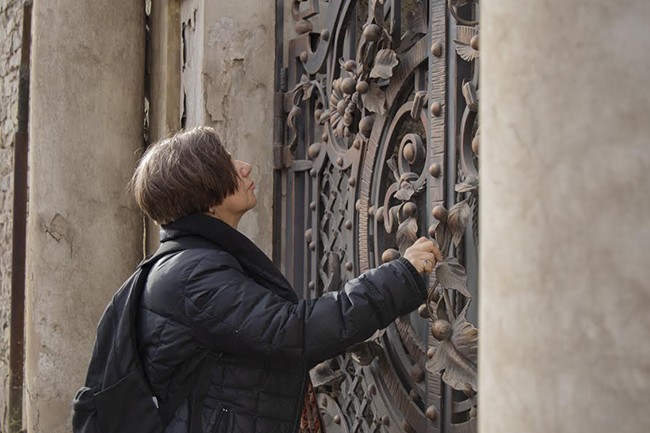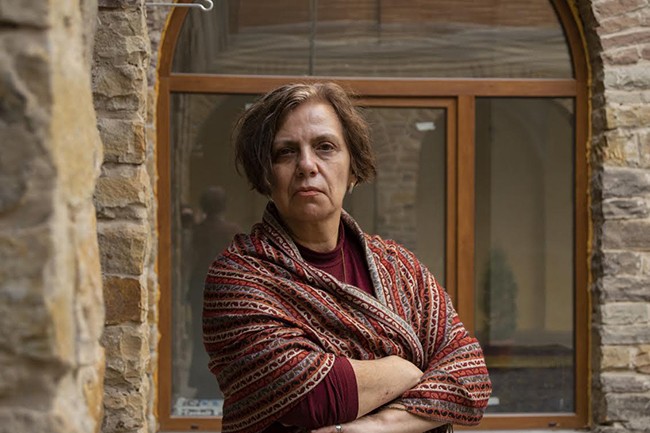“Jewish faces of Catholic saints”: Yevheniya Kononenko on the riddles of small towns and great artists
Yevheniya Kononenko, a Ukrainian writer, translator from the French and English, author of feminist prose works, and a resident of Kyiv, did a residency at the Agnon Literary Center in Buchach. She stayed for one week in this town in Ternopil oblast with a population of twelve thousand, the birthplace of Shmuel Yosef Agnon, winner of the Nobel Prize for Literature and the first Hebrew-speaking writer to be awarded this prize.
Kononenko’s novel Zhertva zabutoho maistra (The Sacrifice of the Forgotten Master) was published in the 2000s and recounts events that happen to a woman, in the words of the woman, in the three Ukrainian cities of Lviv, Buchach, and Kyiv. But these events do not concern the fate of women so much as the dilemma of a sculptor from the Baroque era, Johann Georg Pinsel: the origins of the artist and the artistic riddles in the sculptures on which the master worked differently in Buchach than in Lviv. Pinsel’s works, the only ones in this century, represented Ukraine at the Louvre in Paris.
The Kyiv Daily spoke with Yevheniya Kononenko about the realistic and mystical contexts in the life and works of the mysterious Baroque sculptor and a Jewish national literary idol, and discussed the influence that a provincial Galician Buchach had on these contexts.
The first time
When the idea to write a novel about Pinsel came up, Hrani-T Publishers sent me to Lviv. “Everything you need is there,” they said and paid for a three- or four-day stay in the city. They had in mind the Pinsel Museum and Borys Voznytsky, who was still alive then and had been instrumental in turning the museum into reality. However, they told me not to go to Buchach because “there’s nothing there.” That was in 2006. I arrived on the Feast of the Protection (Ukr. “Pokrova”) of Our Most Holy Lady Theotokos. Later, I couldn’t imagine how I could have written that novel if I had not dared to leave Lviv if only for one day. The writer Liudmyla Taran told me afterwards that she had been in Buchach and spent the night there in a hostel catering to minibus (marshrutka) drivers. But I did not spend the night there. I was told that there was no hotel.
The idea for the novel The Sacrifice of the Forgotten Master arose out of irony. Pinsel’s sculptures date from the eighteenth century. Prior to him, on no other sculpture did I see a similar sickly and, perhaps, even mocking look on a saint’s face. I was struck by the irony evident in the faces. This became the main intrigue, which, of course, I did not solve in my novel. [Volodymyr] Eshkilev did not solve this in his novel either. Why were such saints here in this place? Perhaps because it was far from the Vatican, on the outskirts of Europe. True, there was no Inquisition here either, because this was the eighteenth century, not the seventeenth or sixteenth.
At the same time, I am not an art historian and cannot offer a competent answer, but I sensed something mystical in Buchach the very first time. That’s why the plot of the novel also includes a brief journey to a fairytale-like Buchach and a mysterious man who suddenly appears alongside the heroes, leads them to something important with his story, then just as suddenly disappears. They had not traveled in vain.
Riddles
Pinsel could naturally be Buchach’s tourism brand. In the morning I spoke with a local cultural event organizer. He is upset that nearly all the sculptures were shipped to Lviv. He thinks that they could have been here, at City Hall. I am still preoccupied with Pinsel’s riddles. The first concerns the Jewish faces of Catholic saints, which are not characteristic of European sacred sculpture. The second riddle is the exalted expressions—bordering on the comic—on the faces, which also do not exist in sacred sculpture. From Poles, I heard that this is utter sacrilege: “How can there be such freaks in God’s temple?!“ The third riddle is the riddle of his fate.
Perhaps Pinsel was entirely unconnected to Jews. He married a Polish widow in a Roman Catholic church. As the historian Natalia Yakovenko explained to me, if he married the widow officially, it means that he was an honest type, had his documents in order, was not married illegally. Therefore, Pinsel was not a vagrant, but where he came from is not known. There are no documents recording that such-and-such a person was born and baptized. True, sometimes I think that he was not from Germany but from Czechia. Near Prague is the Kuks Charity Hospital, which I saw; it is decorated with the same kind of sculptures. They are very difficult to photograph, even with modern digital cameras. There is also a record of Mrs. Pinsel’s new marriage, which took place very soon after his disappearance. And that’s another riddle that has not been solved. In my novel, I deliberately did not put forward any definite theory, only hypotheses.
The fourth riddle: Is it possible to get closer to clues, or was this so long ago that nothing can be determined? The fifth riddle concerns the present time. Why do you get a different picture each time? He absolutely could not have predicted this. I think that not even the titans of the Renaissance have such riddles surrounding them, with no answers to this day.
Some see them, others don’t
In Lviv, I looked at the faces of the saints near the cathedral. They are ordinary, no different from the rest of Europe. There is none of that exaltation, bordering on the comic, which is seen in Pinsel’s works. In sacred sculptures in churches, there is usually no corporeal beauty, but there are faces. This is a conflict between secular sculpture and religious sculpture. The outline of the body is practically not shown. I see a conflict between the Jewish and Greek lines in sacred and secular sculpture as well. Judaism forbade the depiction of corporeality. Jews were not allowed to embody human images until the twentieth century.
As for Pinsel, to this day we do not know if he was of Jewish background. It may be that he converted to Christianity because he wanted to create wooden sculptures, his religion forbidding it. This is only a hypothesis, but his creations have clearly Jewish faces. Even Abraham, who tried to kill Isaac, greatly resembles Leonid Finberg, the director of the Center for the Study of the History and Culture of East European Jewry. Leonid is not offended, and I actually have no connection to this [smiles]. In the Dominican Church in Lviv, there are nationally neutral faces, whereas Pinsel’s non-Lviv faces are clearly Jewish and in a state of exaltation. It’s as though a Jew is playing the violin, and he gets so carried away that he has a blissful look about him. This is conveyed in the sculptures. Why? How? Nothing similar can be found in the Christian tradition.
Agnon lived in Buchach much later. At the time that Pinsel arrived in the city for some reason, seventy percent of the population was Jewish. This is what his sculptures depict. Ultimately, what is the lineage of all the apostles? It is not essential to know the Torah; the Gospel, which the Jews read completely differently from the way Christians do, is enough. And Judaism invented angels. They are recorded in the Talmud. With their assistance, God communicates with people. Some see them, others don’t. This is the basis of Jewish mysticism.
My mysticism
“The appearance of the dark forest and the copper of its leaves surrounded the face of the world like a wall”—this epigraph at the beginning of the above-mentioned novel is a quote from Agnon. This is my personal thing, my copper, my mysticism. When I arrived in the city on the Feast of Pokrova, I truly saw a forest and copper-colored mountains above Buchach, and then I read this description in his work. Agnon, who had lived here for years, also saw it. And I was told not to come! Buchach surprised me. I knew about Lviv, Uzhhorod, Odesa, and Kharkiv, but I could not imagine that a raion [provincial district] center could be so beautiful. That’s why there is much in the city that touches me personally. It’s not for nothing that I made a woman the main hero. Events are narrated through her impressions. Previously, I had seen small historic towns in France and Holland, but when trips happened in Ukraine, there was nothing so wonderful: typical bedroom communities and impoverished rural buildings.
Mystical efforts
In the 2000s I read little of Agnon. My text begins with a quotation from his text, but this happens accidentally. When The Sacrifice of the Forgotten Master was being written, the Jewish theme imposed itself. Clearly, there was something very important here in Buchach. Jewry exerted an influence involuntarily, unconsciously. Pinsel depicted Catholic saints with Jewish faces. Agnon wrote his literature two centuries later. Here it’s worth mentioning that Shmuel Yosef was the son of a Hassid, and he often wrote about Hassids. And in their religiousness, there is a stronger mystical component.
In my novel, I remark on the special ability to disconnect from whatever obstructs people. Things often block us. An idea for a strange plan flashes by, but we don’t develop it. Mystical efforts are the ability to reject the rational and to focus on this notion. Sometimes it can be very strong and it itself will drive away everything that interferes, and sometimes you need to help it along. Perhaps the beauty of Buchach had this kind of impact on Agnon’s world perception. Afterwards, of course, he left the city. It was cramped, there was a lack of progress. He was interested in the great truths of Jewry. But after many years he came back again. Then he wrote a lot; among other things, about the incredible beauty of Buchach because of the mountainous terrain. It is quite possible that both Agnon and Pinsel were mystically influenced by the same landscape.
A rationalist text
I think about how the city looked in those days. Well, there were no high-rises, but there were two-storey buildings. Agnon’s A Simple Story describes a plausible version of the life of a town family, an absolutely Jewish but secular family of merchants. I understand the love of which he speaks: the young housemaid and the lord’s son. She feels that her marriage will not happen for lack of money. He decides not to fight but leaves his poor family to hire himself out to a rich one. Of course, the main characters remain in love, but do not even kiss. Their love is described as strong.
Whereas in Agnon’s other texts I saw purely Jewish rules that don’t exist in our country, in this story I see how it is with people. If a Jewish family is described honestly, then any other will recognize itself in it. I even saw a mavka [in Ukrainian mythology, a long-haired female who lures young men into the woods and tickles them to death], who did not feel like fighting for Lukash [the main hero in Lesia Ukrainka’s play The Forest Song]. A Simple Story is an absolutely rationalist text. And Agnon himself, incidentally, married without his father’s blessing. He took as his wife a woman whom he himself wanted, not the one chosen by his parents, even though he was the son of a Hassid. Apparently, they lived well.
There is one Jew living in Buchach now, as a local resident told me. His wife is Ukrainian. Their children are no longer considered as Jews. Many such marriages were made after the Second World War. Sometimes, for example, women hid Jews, and over time the rules of Judaism were violated, although during the interwar period many Jews also abandoned Judaism. The Jewish theme is a page of Buchach.
Text: Marta Konyk
Photos: Yuliia Mykuliak
Yevheniya Kononenko participated in a literary residency in Buchach, supported by the Canadian philanthropic fund Ukrainian Jewish Encounter.
Originally appeared in Ukrainian @Kyiv Daily
Translated from the Ukrainian by Marta D. Olynyk.
Edited by Peter Bejger.






















